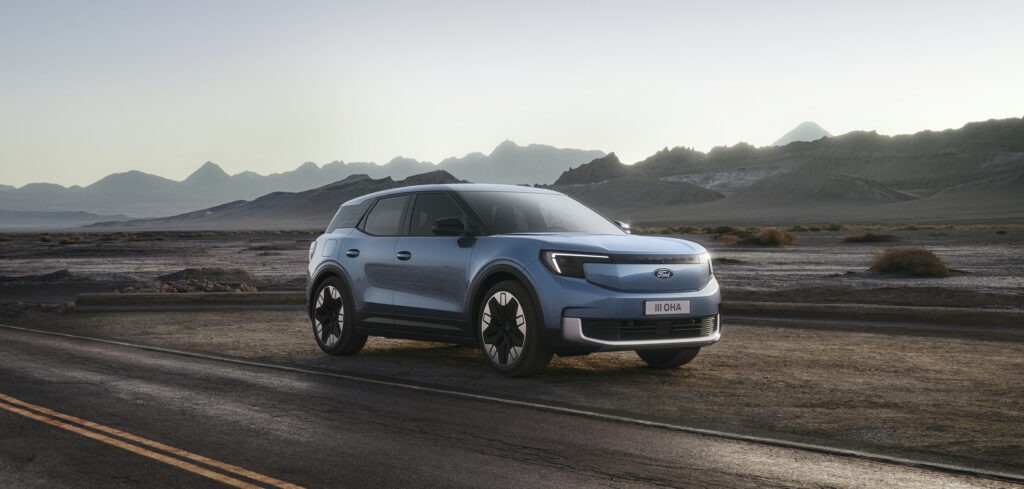Ford on top as UK new LCV market reaches 17th consecutive month of growth
13 June 2024

The UK’s new light-commercial vehicle (LCV) market continued its growth streak in May, with Ford sweeping the board. Andy Picton, chief commercial vehicle editor at Glass’s (part of J.D. Power), investigates the numbers with Autovista24 journalist, Tom Hooker.
The UK’s new LCV market recorded its 17th consecutive month of growth in May, with 25,853 models delivered. Overall registrations rose 1.9% year on year, while battery-electric vehicle (BEV) volumes increased by 3.5% compared to 12 months ago.
This was the best May result for LCVs since 2021. The market achieved growth across all sectors in the month, except for vans between 2.5 and 3.5 tonnes gross-vehicle weight (GVW). In this market, deliveries dropped by 0.8% year on year to 17,042 registrations.
Continuing on from April, rigid commercial vehicles between 3.5 and 6 tonnes GVW enjoyed the biggest improvement of all sectors. LCVs in the weight category surged 80.6% compared to May 2023, reaching 697 deliveries.
Vans below 2 tonnes GVW also saw strong growth, jumping 55.7% year on year, with 730 units.
Elsewhere, deliveries for LCVs between 2 and 2.5 tonnes GVW climbed 8.1% to 4,477 units. Improvement in the pickup sector in May reached 4.1% compared to 12 months ago, with 3,081 registrations.
Despite a marginal delivery decline, vans between 2.5 and 3.5 tonnes GVW dominated the LCV market, with a 65.9% share of registrations in May.
Ford leads the way
Ford took the top three positions in May’s LCV registration table. The Transit Custom finished first, with 3,189 deliveries. This was followed by the Transit, posting 2,505 registrations. The Ford Ranger took third, recording 2,130 units.
Then came the Renault Trafic in fourth with 1,358 registrations and the Volkswagen (VW) Transporter in fifth, reaching 1,265 deliveries. Next, the Mercedes-Benz Sprinter secured sixth, achieving 1,148 units.
Three Stellantis models rounded out the top 10. The Peugeot Partner finished in eighth (855 units), the Vauxhall Vivaro came ninth (827 units) and the Citroen Berlingo ended the month in 10th (789 units).
BEV uncertainty
The UK’s BEV LCV market enjoyed growth in May, thanks to 1,077 registrations. The sector accounted for 4.2% of the market, up just 0.1 percentage points (pp) compared to May 2023.
However, across the first five months of 2024, deliveries were down 2.1% year on year, at 6,877 units.
From January to May, BEVs took a 4.8% share of the new LCV market, down 0.4pp compared to the same period in 2023. This is also a significant distance behind the zero-emission vehicle (ZEV) mandate target. Under these rules, each manufacturer must ensure that 10% of their registered vans must be ZEVs by the end of this year.
Current results reflect a market unsure of how to integrate BEVs into operational processes. Additionally, a general election in the UK has recently been set for July. This may create uncertainty around existing plans for economic incentives focused on ZEVs.
VW victorious
VW was the best-selling BEV brand in May. With 220 all-electric models delivered, the manufacturer took a 19% share of the new electric van market.
Peugeot reached 176 BEV units in second (15.2% share), while Vauxhall took third thanks to 163 deliveries (14.1% share). Ford finished fourth with 138 units (11.9% share) followed by Maxus and Citroen in joint fifth, posting 115 registrations (10% share each).
Accounting for all of VW’s plug-in volume, the ID.Buzz Cargo was the UK’s best-selling all-electric LCV last month, achieving 220 deliveries.
The Peugeot e-Expert secured second with 127 units, as the Vauxhall Vivaro Electric reached 109 registrations in third. Fourth place went to the Citroen e-Dispatch (107 units) while the Ford E-Transit claimed fifth (83 units).
Across the first five months of 2024, only BYD (100% share), Maxus (14.4% share), Peugeot (13.2% share) and Nissan (10.3% share) are on track to meet their 10% ZEV mandate target. Behind, Vauxhall is moving in the right direction, with a 7.4% share at the end of May, alongside VW (6.8% share), Renault (6.6% share) and Toyota (6.3% share).
An additional 77 BEVs above 3.5 tonnes GVW from Fiat, Ford, Iveco, Maxus and Mercedes-Benz were registered last month. This gave an overall commercial BEV delivery total of 1,154 units.
More cautious buyers
Due to increased stock levels, as well as half-term and bank holidays, used LCV appetites and prices softened in May. The month saw buyers bidding more cautiously, a trend that is likely to continue against a relatively flat retail market backdrop.
Any clean, low-mileage stock remains attractive for trade buyers seeking a quick sale. Harder-worked and higher mileage examples requiring more preparation before selling have seen conversion rates drop.
A lower overall volume of used sales was recorded in May. Euro 6 vehicles made up over 79% of the used-LCV market at an average age of 53.8 months, up 1.9 months on April 2024. Average mileage increased by 7% to just over 73,650 miles (118,528km). Meanwhile, the average selling price was £9,025 (€10,676), down £925.
A lack of enthusiasm saw used electric vans account for 1.2% of all sales at auction, a decline of 0.2pp compared to April. The average age of these vehicles was 65.7 months, a drop of 4.6 months on April 2024.
The average mileage was just over 30,400 miles. The average selling price increased by just under £1,200 compared to April, sitting at nearly £5,375.
Euro 5 stock made up the remaining 19.6% of sales, slumping 1.7pp on the previous period.
Decreasing sales
In May, used-LCV sales decreased by just under 11%, with average sales prices falling by nearly 6.8%. This figure was 17.9% below price levels seen in May 2023.
The average age of sold stock fell from 73.9 months in April to 73 months in May. Year on year, stock age was 8.1 months lower. Average mileage increased by nearly 4.2% in May, from 76,226 miles to 79,537 miles. This was over 4.6% higher than May 2023.
Medium vans remained the most popular LCV type at auction, accounting for 34.6% of sales in May. Small vans took a 27.7% share, while large vans accounted for 26.1% of transactions.
Pickup stock accounted for only 11.5% of all sales, yet attracted the strongest average sale price of £12,850, up £36 on April 2024.
Meanwhile, large vans covered more distance than any other vehicle type at an average of 83,791 miles. This was an increase of over 1,500 miles on April 2024, but 725 miles lower than 12 months ago.
Conversion rates drop
First-time conversion rates dropped by 6pp in May to 66.7% overall. This result was 8.8% lower than in May 2023.
The best conversion rates were achieved in the small-van sector at 72.4%, a 7pp decline month on month. Average conversion rates of 63.6% in the medium-van sector returned the lowest, down 6pp on April.
Used vehicles observed for sale in the retail market last month increased by nearly 2.5% to just over 45,500 units. Of these, 94% were diesel and 3.5% were BEVs.
Of all vehicles on sale, 41.2% were valued at £20,000 or more, while 38.2% were on sale for between £20,000 and £10,000.
Vehicles on sale for between £10,000 and £5,000 made up 16.6% of the overall market, and 4.5% were on sale for less than £5,000.
The average age of all vehicles increased by one month to 56 months, while the average mileage increased by 1.4% in May, to nearly 59,250 miles.



